
Daily Mountain
48 years, Australia
The First Dog Ascent of a 7,000-Meter Himalayan Peak
We don't want to hear about the time your dog did a fourteener. Mera, recently renamed Baru, made the first canine ascent of Nepal's 23,389-foot Baruntse in November 2018.
On November 9, 2018, a dog named Mera became the first of her kind to reach the summit of Baruntse, a 23,389-foot peak in Nepal’s Himalayas, located just south of Mount Everest. The peak, often overlooked as it lies in the shadow of some of the tallest mountains in the world, is a steep, challenging climb in its own right. Other than a brief human-aided zip line down a short section of fixed line, Mera made the ascent completely unsupported.
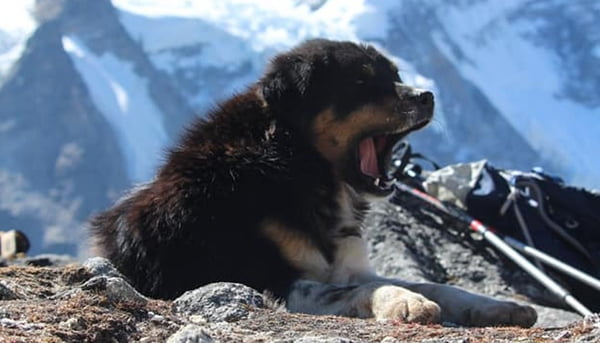 Mera (now Beru) relaxes during her climb
Mera (now Beru) relaxes during her climb
“I am not aware of a dog actually summiting an expedition peak in Nepal,” says Billi Bierling of the Himalayan Database, an organization that documents climbing expeditions in Nepal. “I just hope that she won’t get into trouble for having climbed Baruntse without a permit.” According to Bierling, there have been a few cases of dogs at Everest Base Camp (17,600 feet) and some who’ve followed teams through the Khumbu Icefall up to Camp II (21,300 feet), but this is perhaps the highest-recorded elevation ever reached by a dog anywhere in the world.
Mera, age unknown, is a 45-pound Nepalese mutt who appears to be a cross between a Tibetan mastiff and a Himalayan sheepdog. She possesses an extraordinary level of confidence relative to her small frame. Though slight, she’s lean, with muscles likely honed by years of travel over rough mountainous terrain in the Khumbu Valley. She has soft, close-cropped black fur, with legs and a snout dipped in golden yellow, small ears that flop forward, and kind eyes.
Mera embedded with a team from the Kathmandu-based Summit Climb, led by Seattle-based mountain guide Don Wargowsky, in the tenth day of its monthlong expedition. The group had seen her a few days before in the Nepalese town of Kare, but she seemed aloof. The team members were descending from a successful summit of Mera Peak (21,247 feet), the first mountain they had climbed on their trip before heading to Baruntse, and were just above the fixed lines at around 17,500 feet when Mera (you can see how the humans decided on her name) came bounding toward them. She passed about 30 climbers on the way up, all of whom could’ve been persuaded to give her food or attention, but she crossed a glacier with a crevasse and beelined it for Wargowsky.
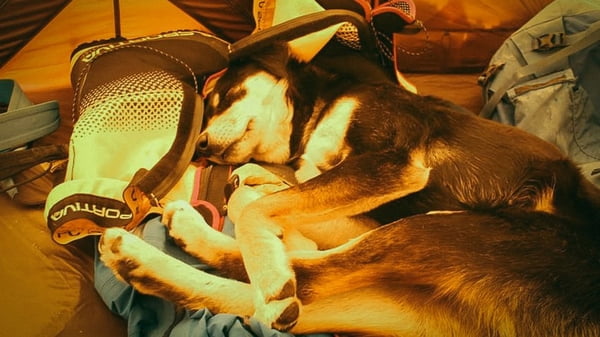 Photo credit: Don Wargowsky
Photo credit: Don Wargowsky
From that point on, the two were inseparable. He gave her a sleeping pad and jacket for a bed nest, and in return she fashioned herself into the ideal tent partner for three weeks: quiet, cuddly, agreeable, and with a small stomach. “One morning we got wind so bad it ripped the anchors off the tent, picked it up, and moved it a few feet,” Wargowsky recalls. “She just woke up, looked at me, and went back to sleep.”
Mera very quickly became the team’s mascot.
Because of the prevalence of rabies in Nepal’s street dogs, strays are generally not treated especially well. Mera, skittish around humans, was eventually placated by head pats and pieces of meat. She followed Summit Climb’s Sherpas as they fixed ropes to Baruntse’s camp one (20,100 feet), climbing steep snow to a section of easy rock scrambling. On the way down, however, she appeared spooked by the steepness and wouldn’t follow them back to base camp.
She spent two nights at camp one out in the open, alone on the glacier. It was bitterly cold and winds were high. “I was certain she was going to die up there,” says Wargowsky. When the Sherpas went back up to fix the route to camp two, he asked them to bring her back down if she was still alive. But she’d survived and decided to accompany the Sherpas as they worked their way up to 22,500 feet before going back to base camp.
“Imagine that instead of crampons, you have claws,” Wargowsky says. “Her feet were bloodied. She had busted knuckles and broken toenails. It was hard to see.”
At first it seemed like the Sherpas only tolerated Mera because Wargowsky liked her so much, but as they witnessed her climbing prowess, they began to treat her with reverence. “They’d never seen anything like this happen. They said she was a special dog, that she brought luck to the expedition,” Wargowsky says. “Some even thought she was blessed.”
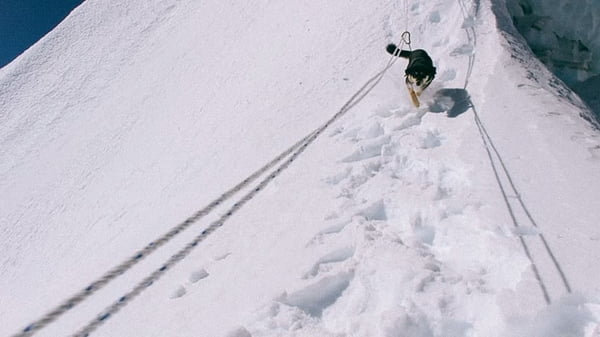 Photo credit: Don Wargowsky
Photo credit: Don Wargowsky
The next day, Wargowsky took his team up to camp one to start the summit bid. The route features steep ridgelines that drop thousands of feet off either side. There are sections of vertical snow. To get down, climbers have to do a number of rappels. Wargowsky tied Mera up at camp so she couldn’t follow them back up the mountain, but the dog chewed through the rope and caught up with the team less than an hour after it had left. “She just tucked in right behind me,” he says. “And it’s not like I could leave the clients to take her back, so it meant she was going with us.”
It was early in the day, and the snow was firm en route to camp one. Mera was up ahead of Wargowsky when she started to slip. He hung onto the fixed line with one hand and grabbed her with the other, saving her from what could’ve been a 600-foot tumble. The team spent a night at camp one and then moved up to camp two. Usually teams stay there only briefly before launching their summit push, but bad weather kept the group put for four days. Wargowsky let Mera split his meals of soup and pasta.
After the 60-to-70-mile-per-hour winds abated at Baruntse’s camp two (21,000 feet), the team set out for the summit at 2 A.M. When the team left, Mera was still sleeping. Wargowsky was relieved. Though she had shown strong climbing skills, he still didn’t want her following them. He’d already seen her slip once.
Mera slept until daybreak, then ran off to find the team. She moved quickly over a moderately steep, glaciated section of the route, taking just two hours to cover what took the humans seven to complete. She seemed unbothered by the exposed ridgeline and huge drop-offs, bounding ahead of the group and then running back as if annoyed by its slow pace. “I have no clue if she’d been up there before, but she seemed very confident in what she was doing,” Wargowsky says.
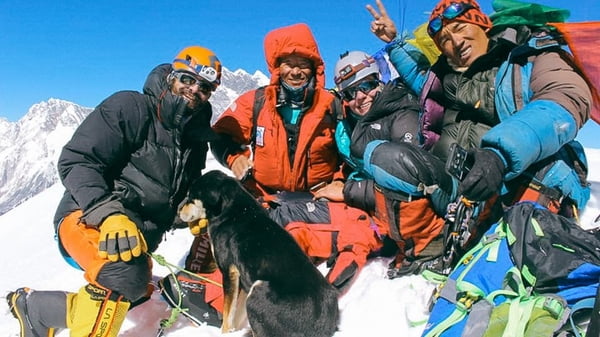 Photo credit: Don Wargowsky
Photo credit: Don Wargowsky
It turned into a clear, blue-sky day, but temperatures were cold, with strong gusts of around 30 to 40 mph and a windchill of minus 20 degrees. “It was the coldest my feet have ever been,” says Wargowsky. Those in his group wore expensive 8,000-meter down suits and heavy double boots. They had crampons and carried ice axes, both giving them purchase and security in the firm snow and ice. Mera, who seems to prefer a more Wim Hof style of alpine travel, wore nothing. For reference, the official Iditarod rules require mushers to carry eight booties for each dog in order to offer abrasion protection from the snow and ice.
On the final ridge to the summit, Mera ran ahead of Wargowsky and the one client who was able to continue and waited for them on top, tongue out and panting. “I’d never been on top of something like that with a dog. She was leaning up against me and wanting to be petted. It was pretty surreal.” At an altitude where even humans in the best shape of their lives are slowed to a crawl, Mera could run.
Baruntse climbs are open to beginners, and most operators don’t require previous mountaineering experience. However, there are fixed ropes and altitude to navigate. Lakpa Rita Sherpa, a senior guide for Alpine Ascents International and one of Outside’s 2013 Adventurers of the Year, has guided the peak twice. “Baruntse is a pretty easy climb except for summit day,” he says, comparing it in difficulty to Mount Rainier. “I don’t know how the dog got all the way to the summit. There are a few difficult sections, and from the mushroom ridge, you’re on a very exposed ridge for a couple of hours.” He remembers a dog on Mount Everest who followed him to Camp II and tried to go to Camp III but didn’t have enough grip. He ended up becoming snow-blind, and a Sherpa carried him back to Base Camp.
If Mera could speak, she might credit that two-night open bivy as the key to her successful acclimatization. But dogs, like humans, are susceptible to altitude sickness: the extreme fatigue, headaches, and vomiting, as well as killers like high-altitude pulmonary and cerebral edema. Wargowsky’s Baruntse team started with six climbers, but only one was in good health to climb on summit day. It’s a tough environment.
“Her antecedents certainly suggest a dog with the genetic disposition to succeed at high altitudes,” says Martha Tissot Van Patot, a Colorado-based cardiovascular pulmonary physiologist who focuses on hypoxia and altitude research. Luckily for Mera, some species, including Tibetan mastiffs, possess physiological adaptations for performance at elevation.
Still, everyone, and every dog, who climbs mountains knows that the summit is only the halfway point. In fact, most accidents happen on the descent. Certain Sherpas or guides might be comfortable descending unroped, but there were even sections that Wargowsky wanted to rappel and that the Sherpas were clipping into the rope for. Yet Mera went down on her own.
There was only one instance in which she appeared to be scared: where the route descends a short vertical headwall (that she’d managed to climb up). The team’s lead Sherpa tied a cordelette around Mera and clipped it to the rope. She then half-ran, half-slid to Wargowsky before taking off ahead of the group down the ridge. “She had a lot of faith in me and the Sherpas to help her, but she really didn’t need any help. She did everything on her own,” Wargowsky says.
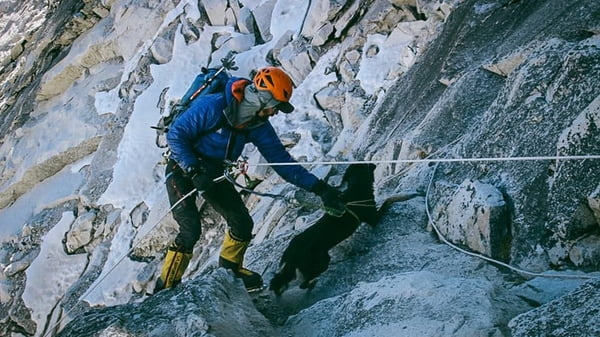 Photo credit: Don Wargowsky
Photo credit: Don Wargowsky
Mera became an instant celebrity. People came over from other camps to meet the dog who’d summited Baruntse. Some tried to discredit her, saying it was impossible. Luckily, the team had plenty of photographic evidence. Mera declined to comment for this piece, preferring instead that her accomplishment speak for itself. And to be clear, no one forced Mera to climb this mountain. In fact, Mera’s feat made the climbers very anxious.
The walk back to Lukla, the mountain airport where climbers board Twin Otters to fly back to Kathmandu, takes a few days. Stray dogs are not welcome inside teahouses, but Mera was (now per usual) an exception to the rule. She slept in Wargowsky’s bed, curled up at his feet. Kaji Sherpa, the expedition’s base-camp manager, would order Mera her own entrée as he ate his own dal bhat.
“Back on the trail, walking toward home, it dawned on me: we’d have to go back to Lukla and leave Mera on the street,” Wargowsky says. “I was sick about it. I told Kaji it was breaking my heart to think of leaving her. He said, ‘No way, she’s special. She’s coming with me.’” Mera couldn’t fly, so Kaji paid someone $100 to walk three days to Lukla to pick her up and then three days back out with her to a village with bus service to Kathmandu.
On Christmas Day, Kaji sent photos to Wargowsky. He’s renamed her Baru, since she climbed Baruntse. Baru has put back on the weight she lost from the climb and is happy and well-fed.
This article first appeared on http://www.outsideonline.com. The original can be read here.





